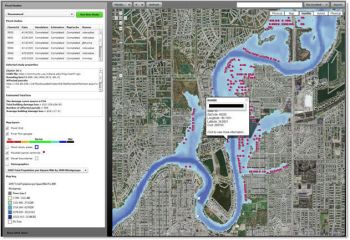Inundation Mapping

|
| A flooding inundation map
(Image Source: USGS, 2019) |
“There are no available Federal agency guidelines specifically developed for non-Federal entities that provide both current modeling and geographic information system (GIS)-based mapping standards for dam breach inundation mapping efforts that can be used directly by States to regulate the preparation of consistent dam breach inundation studies. The models and maps created as part of a dam breach inundation study can be used for hazard potential classification, in developing Emergency Action Plans (EAPs), and to conduct dam breach consequence and hazard mitigation studies”.[1]
“To evaluate the effects of dam failure, maps should be prepared delineating the area which would be inundated in the event of failure. Land uses and significant development or improvements within the area of inundation should be indicated. The maps should be equivalent to or more detailed than the USGS quadrangle maps, 7.5-min series, or of sufficient scale and detail to identify clearly the area that should be evacuated if there is evident danger of failure of the dam”.[2]
“Inundation mapping is the product of an engineering analysis, which involves numeric hydraulic modeling, dam breach analysis, and interpretation of a dam’s potential failure modes…
“The mapping specialists use output data from the hydraulic modeling to produce flood inundation maps. Mapping is completed with either one-dimensional (1D) or two-dimensional (2D) hydraulic modeling results, or via a combination of the two (1D & 2D), depending on the study. Standard products include mapping the maximum flooded extent in conjunction with discharge information, maximum depths, and flood leading edge-time to maximum flooding travel times. Note that 1D and 2D inundation maps have different formats and data requirements. Specialty maps include mapping flooding intensity, represented by the product of maximum depth and velocity (DV) values. Various ancillary data layers are added to the map for context, including recent aerial imagery, rivers and streams, roads, and populated places”.[3]
Best Practices Resources
![]() Emergency Action Planning for Dams (FEMA P-64), FEMA
Emergency Action Planning for Dams (FEMA P-64), FEMA
![]() Flood Inundation Mapping, USBR
Flood Inundation Mapping, USBR
![]() Hydrologic Engineering Requirements for Reservoirs (EM 1110-2-1420), USACE
Hydrologic Engineering Requirements for Reservoirs (EM 1110-2-1420), USACE
Trainings
![]() On-Demand Webinar: The State of the Practice and Future of Dam Breach Modeling
On-Demand Webinar: The State of the Practice and Future of Dam Breach Modeling
Citations:
Revision ID: 7333
Revision Date: 07/19/2023
